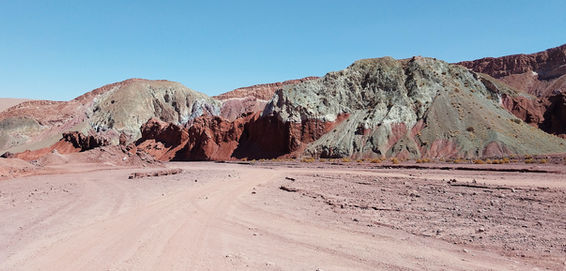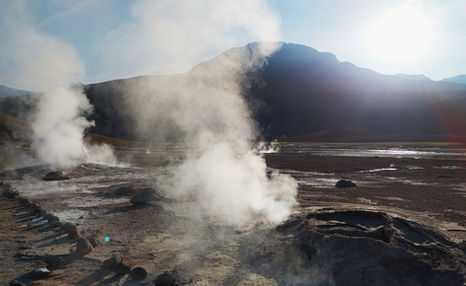
Atacama Desert (Part 2)
Chile
The Atacama Desert is full of volcanoes, and while they weren't my top priority here, I wanted to at least climb one. Danny knew the altitude was beyond him, so I drove solo out to Cerro Toco, the shortest and least technical volcano near San Pedro de Atacama. Ignoring all the 'no entry' signs, I carefully manoeuvred along a potholed road up the mountain to a car park in front of an observatory (later on I saw cars parked further up the volcano, which would have reduced my hike by about a third). From my starting point, the elevation was already at 5,150 m. I was definitely not acclimatised for this trek, but I was hoping I would make it if I took it slowly.
There were paths leading in various directions up the slope, yet they all seemed to end up at the top. I tried to follow the path outlined on my phone, but somehow I twice ended up going in a different direction. The trail was entirely on loose gravel, which wasn't technically difficult although it did increase my energy expenditure. My heart was racing from the first step, but as long as I kept my pace at a slow plod, I could maintain the momentum.
The summit, at 5,604 m, took me about an hour and 20 minutes to reach. A haphazard pile of stones and a little flag marked my arrival. All around was a sea of mountains in various shades of red, brown and yellow, many of them in Bolivia (the border was only a few kilometres away). Once again Volcan Licancabur dominated the view, and from this perspective I could see a light blue lake curving around its base. Surprisingly, I wasn't cold at all, and the wind was contained to a small section of the peak. I had the whole place to myself, and I enjoyed the silent setting for 20 minutes before commencing the descent.
On the way down I chose a slightly different route, giving me new angles to take photos from. I passed a handful of other groups on their way up, making me glad I had made the early start. It was a straightforward trek and I made it to the bottom in 35 minutes. Then it was an hour’s drive back to town, where I picked up Danny to continue our exploration of the Atacama.

Our destination for the afternoon was Valle del Arcoiris (Rainbow Valley). Searching online, this didn't appear to be as popular as other Atacama sights, but the promise of colourful rocks had put it high on my list. It ended up being one of our favourite spots of the region.
It was an easy drive to the Rainbow Valley, and as soon as we turned off the main road the colours started appearing. After paying the entrance fee, we parked the car and set off by foot to examine the scenery up close. Immediately we were immersed in a sea of craggy red rocks of all shapes and sizes, some towering over us. Many of the rocks were covered in a light green moss that gave the appearance of mould growing over its surface. Shades of orange, brown and white were also thrown in, creating a fascinating Mars-like wonderland. I expected to spend around 30 minutes or so at the site, but we ended up exploring the multitude of trails for 2 and a half hours, climbing up and down the rocks and inspecting every nook and cranny. I would have stayed longer if time wasn't against us. My photos don’t do it justice.
Due to the high percentage of cloud free days, as well as limited light pollution and radio interference, the Atacama is apparently one of the best places on earth for star-gazing. We signed up for a late-night tour located at an observatory away from town. A full moon stared down on us, which didn't work to our advantage as the light obscured most of the stars in the sky.
The first half of the tour had us manipulating telescopes, with the aid of lasers, to view a selection of stars in the sky. Venus and Jupiter just looked like tiny white dots in our telescopes, so they weren’t that impressive. Canopus, the second brightest star in the sky, was close to the horizon and displayed a dazzling range of colours, almost like a disco ball. My favourite sighting was of Saturn, as we could just make out the minuscule rings surrounding the bright speck. With the use of a filter we zoomed right in on the moon, its craters clearly visible to us. Our guide then used a long exposure setting on his digital telescope to take a photo of the nebula around the stars of Orion's belt, approximately 1,300 light years away. In theory it sounded fascinating, but the photo just showed us a blur of light.
After a wine and snacks break we were taken to the second part of the tour, which was a photography session for all the people who wanted photos of themselves for social media. Each group was taken one at a time to a camera with a view of the night sky behind them. Most couples asked for multiple angles and revisions to get the perfect shot. We did not. We asked for one photo, sitting with our backs to the camera, and we were done. This part was definitely a lowlight for us, but it didn’t attract from our enjoyment of the start of the night.



Due to our star-gazing tour last night, we didn't get to bed until after 12.30 a.m. The 4 a.m. alarm for this morning's tour was not a welcome sound. We were headed to El Tatio Geyser, a place we had planned to visit by ourselves until we read reports about how atrocious the road conditions were. In the end, the roads were fine and plenty of people had driven themselves. Don't believe everything you read online.
Once our bus had picked up all its passengers, we made the 1.5 hour journey north, climbing up to 4,200 m. The sun still hadn't risen when we arrived and the temperature was below freezing. I was not at all prepared for this (I blame it on the lack of sleep). My body shivered the entire time we wandered around the vast geothermal field, where columns of steam spewed out of the earth from a multitude of fumaroles, some reaching 10 metres high. Several also had hot water bubbling out of the vent, which came and went at regular intervals. When the sun finally popped up, the entire site suddenly took on an unworldly appearance as the light hit the steam. It was beautiful to watch, and thankfully didn't smell like rotten eggs.
Afterwards, we ate breakfast overlooking the geysers from a distance, where a couple of wily foxes wandered past in search of scraps. We were warned not to get close as they have been known to attack humans. They came within a metre of us and didn't seem to mind our presence. I’m sure they had no trouble finding food every morning, judging by the number of tour groups set up around us.

On the way back to town, passing by herds of llamas, vicuñas and ostriches, we stopped briefly at 2 wetlands, an unusual sight in such a dry place. The first contained a variety of water birds, including Andean ducks (sporting distinctive blue beaks), Andean geese, sandpipers and giant coots. The bird sightings from the car were spectacular. From the mirador, situated high above the lake, they weren't so impressive, although the active volcanoes in the background made a stunning backdrop.
The second wetland was all about flamingos. Hundreds of the birds were spread out across the water, but most were sitting well back from the road. The setting didn't compare at all to Laguna Chaxa, but I always appreciate the opportunity to see flamingos in the wild.















































